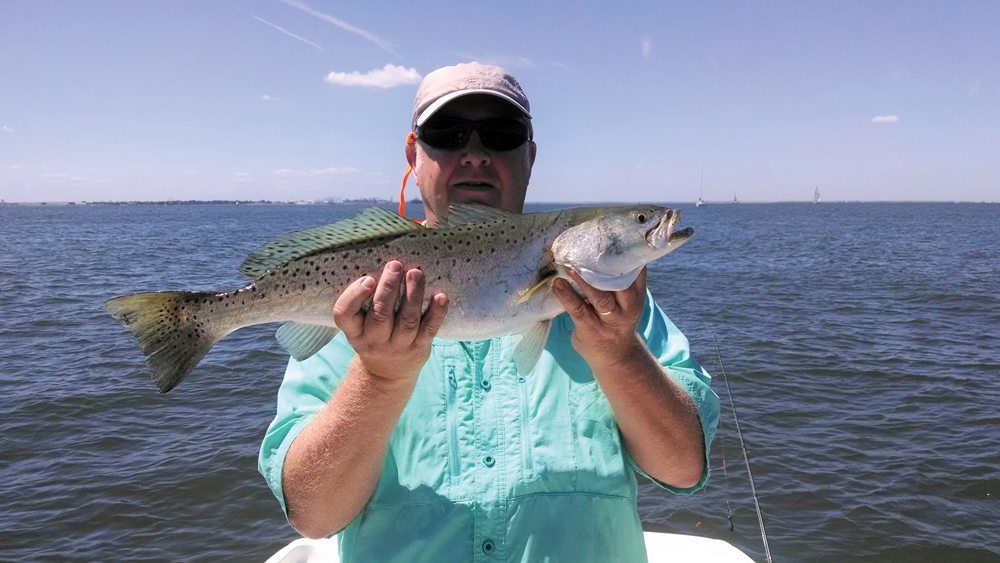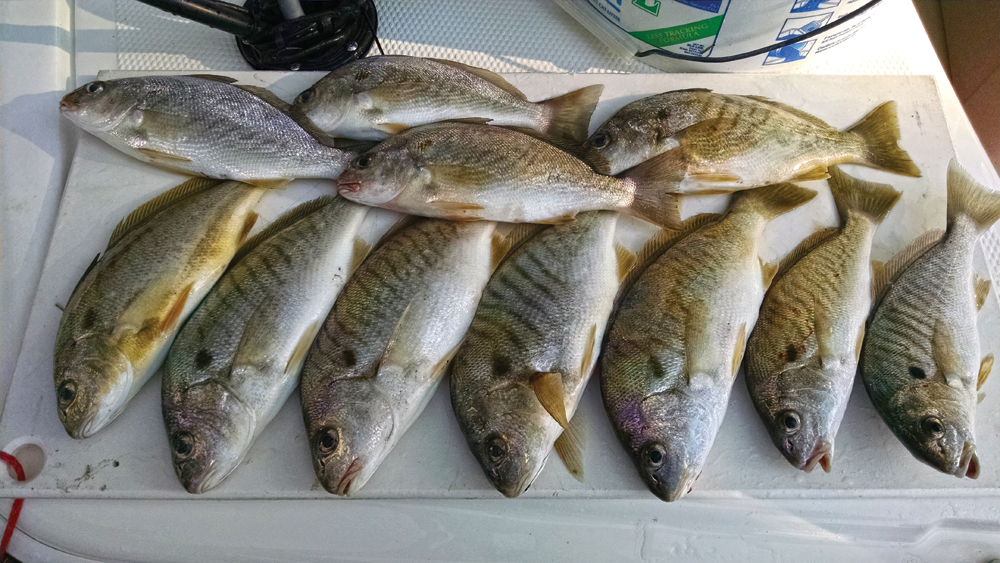I spend a lot of time poking around the Hampton Roads Bridge Tunnel (HRBT), in no small part because I fish in a 16-foot Mako ProSkiff (one of our 10 Top Center Console Fishing Boats Under $20,000!) It’s a well-built boat with a hull that can take the chop. But it is, after all, a 16-foot boat with low sides, which means my range is a bit limited. I usually launch out of Old Point Marina in Hampton, which is literally a few hundred yards from the HRBT. Sometimes the fishing is hot and sometimes it’s not, but there’s usually something happening there if you know where to look. (Visit our Way South and VA fishing reports for the latest intel.)

River, Harbor, and Bay
The HRBT offers a unique habitat with several dynamic influences. There is the James River, which flows from the mountains of Virginia to the Hampton Roads Harbor. At its mouth, the river is several miles wide. The lower end of the river is tidal, with the outgoing tide stronger since it’s flowing with the river. The harbor itself is a large basin which has been a safe place for ships to anchor for 400 years.
The term “Hampton Roads” refers to the anchorage in the harbor. (You real nautical types know that on the water, a “road” is an anchorage.) This area has played a huge part in our nation’s history, from the arrival of the Jamestown settlers to the battle of the Monitor and Merrimac (or as Southern historians prefer – the C.S.S. Virginia). Abe Lincoln stood on Fort Wool, adjacent to the HRBT, to watch the battle.
The HRBT marks the dividing line between the harbor and the Chesapeake Bay. The currents here can be strong when Bay water funnels through this opening, into and out of the harbor on a spring tide. This dynamic of river and Bay coming together means that some species that thrive just a few miles away at the Chesapeake Bay Bridge Tunnel (CBBT) are rarely found at the HRBT. Most of the HRBT species are comfortable in a salty to brackish environment. These include spot, croaker, flounder, gray trout, speckled trout, bluefish, stripers, and (puppy) red drum. Other species may be found there, but these are the most consistent.

Seasonal Offerings
In the spring and fall, the main targets are specks and pups. Speckled sea trout stop here as they migrate in and later when they migrate out of the area. At times they’re plentiful, bunched up along the sides or end of the island on the Hampton side of the tunnel. I typically drift down the harbor side of the island on a falling tide, and if I find the fish, I’ll slip the anchor over the side. If I don’t find them there, I’ll work the tube end of the island.
A word of warning: the rocks over the tube are just under the surface in many places. Be careful in this area, especially on the southbound tube. The rocks there extend out quite a way from the island itself. This makes it a great place for the fish to ambush bait, but also a good place to break a skeg or bend a prop. Don’t ask me how I know this…
Depending on the current, it’s effective to anchor up-current or down-current of these rocks and work jigs in this area. As for baits and gear, a half-ounce lead-head jig with a Gulp tail on a lightweight spinning outfit spooled with braid is ideal. Since you’re never in more than 10 feet of water, this size jig works well. Color doesn’t make much difference, as long as you get it down to the strike zone along the bottom.
Everything I just said about specks is also true for puppy drum. They hang out in the same areas and hit the same baits, and during some seasons the pups will stick around through the summer. These fish are often in the 22- to 28-inch range, making for a fun fight on light tackle. I have caught a few reds above 30 inches anchored up using small live spot or croaker for bait.
Flounder usually begin showing up in this area in late spring. Sometimes they hit the jig you’ll use for specks, other times a tandem rig with two jigs is the better move.
Small bluefish are a constant aggravation from summer through early fall. They are seemingly everywhere, and they love nothing more than to bite the tail off the Gulp. Sometimes when nothing else is biting, you can play with slightly larger bluefish mixed in with small gray trout. These will congregate on the Norfolk side (more about the location in a minute). For these, small Sting Silver-type jigs are good. We all long for the days when larger gray trout come back to the Bay, but these are very cyclical fish and we’ve been in the low end of the cycle for several years. In times past, the HRBT has been an excellent location for nice grays.
School stripers are another possibility at the HRBT in early spring and late fall. It’s been a few years since I caught any bigger stripers in this area. These are usually found hanging around pilings on either end of the bridge.
What have we left out? Oh yeah, spot and croakers. They are plentiful in this area. Croakers show up in spring as the water warms. The spot follow. Towards the end of the summer – around the beginning of September – we get a run of spot here that are big enough for the dinner table. I can’t resist a fresh fried spot!
HRBT Hot Spots
Let’s take a virtual fishing trip at some of the HRBT’s best hotspots; the numbers in parentheses refer to locations on the map at the beginning of this article. Starting at Old Point Comfort Marina, head along the marina breakwater (1) to the place where boats enter and exit the docks. Drop small pieces of bloodworm flavored Fishbite on #4 hooks. Within minutes, you’ll typically have several spot and croakers in the live well.
Next, motor to the island on the Hampton side of the HRBT – literally a few hundred feet away. Drift flounder jigs through the two bridges (2) between the second to the fourth sets of pilings. Try this a few times. If nothing happens, jig for specks on the harbor side of the island (3). Drag a flounder jig from another rod, as you work down the island.
Once reaching the tube end of the island (4), cast around (as mentioned above) looking for specks or pups. Then, move across the harbor to the Norfolk side to drift along the rocks near Fort Wool (5) for flounder. There’s a lot of bottom contour in this area. Back in the days of large gray trout, this was a productive spot.
At this point, it’s time to motor over to the bridge several pilings from the island (6) and work a jig around the pilings. I’ve caught just about everything in this area at one time or another, and this is where I’ve run into large schools of small bluefish and/or gray trout working the bottom in recent years.
The final stop is on the harbor side of the island (7). Drift for flounder here on an incoming tide under the bridge – about eight pilings from the rocks – until you’re past the side of the island. The bottom is chunky here, so don’t drag your rigs, but rather bounce them along the bottom.
I rarely manage to work all these spots in one day, but this gives you an idea of where to look for fish around this structure. The HRBT can be hit or miss, but that’s true of most fishing spots. You’ll usually manage to find something happening somewhere in at least one of these spots, for at least one of these species – and the bonus is that you don’t even burn three gallons of gas!
~ By Chuck Harrison

Tips for Fishing the Hampton Roads Bridge Tunnel
- There is also a ramp in Willoughby on the Norfolk side of the HRBT. If you use that ramp, be sure to follow the channel to the bridge. There’s a lot of seriously shallow water on that side.
- This is an excellent location for “yikkers.” People launch on either side for a short paddle to the fishing grounds.
- Don’t feel like you must fish only on the structure. There are plenty of spots nearby that hold fish – but that’s for another story.
Sign up here to get the weekly FishTalk Chesapeake Bay and Mid-Atlantic fishing reports in your email inbox, every Friday by noon.